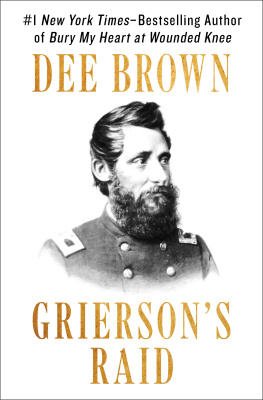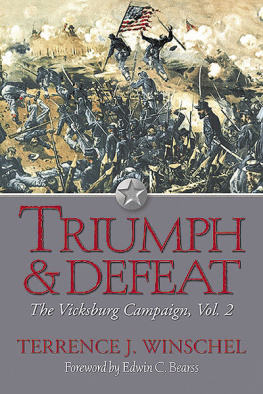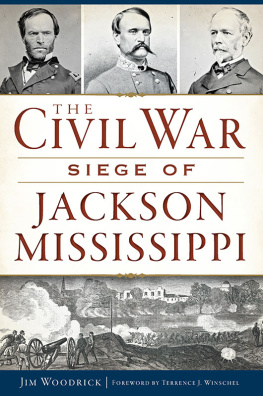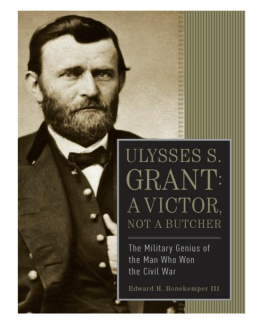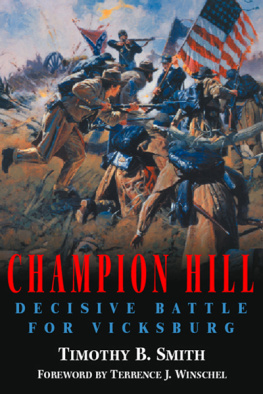

Published by The History Press
Charleston, SC 29403
www.historypress.net
Copyright 2011 by Brandon H. Beck
All rights reserved
First published 2011
e-book edition 2012
ISBN 978.1.61423.327.5
Library of Congress Cataloging-in-Publication Data
Beck, Brandon H., 1944
Holly Springs : Van Dorn, the CSS Arkansas, and the raid that saved Vicksburg / Brandon
H. Beck.
p. cm.
Includes bibliographical references.
print edition ISBN 978-1-60949-049-2
1. Holly Springs (Miss.)--History, Military--19th century. 2. Van Dorn, Earl, 1820-1863. 3. Arkansas (Confederate ram) 4. Vicksburg (Miss.)--History--Civil War, 1861-1865. 5. Mississippi--History--Civil War, 1861-1865--Campaigns. I. Title. II. Title: Van Dorn, the CSS Arkansas, and the raid that saved Vicksburg.
F349.H79B43 2011
355.00976288--dc23
2011039232
Notice: The information in this book is true and complete to the best of our knowledge. It is offered without guarantee on the part of the author or The History Press. The author and The History Press disclaim all liability in connection with the use of this book.
All rights reserved. No part of this book may be reproduced or transmitted in any form whatsoever without prior written permission from the publisher except in the case of brief quotations embodied in critical articles and reviews.
For Malachi Thomas Beck, born April 3, 2011
Contents
Acknowledgements
I owe many thanks to the following historians, descendants of soldiers, archivists and librarians, guides and photographers. John Anderson, preservation officer of the Texas State Library and Archives Commission, provided me with the photograph of Colonel Griffith. Dr. Mike Ballard, of Mississippi State University, explained some of the fundamental problems of the North Mississippi campaign. Dr. Sid Bondurant, of Grenada, provided information on Van Dorns route from Streathans Plantation in Grenada to Houston. Ben Bowen, of Deer Lake, Texas, shared his knowledge of Texas cavalry. Garrie Colhoun, of Holly Springs, is a knowledgeable guide and expert photographer. Susan Chadwell Dignard and Kenneth Hurt agreed to let me use the diary of Lieutenant Alexander Chadwell, 2nd Missouri Cavalry. Joe Douglas, of Columbus, Mississippi, shared his ancestors experiences in the 1st Mississippi Cavalry. Thanks to John Fox for references to important sources. Gail Gunter, of the Fant Memorial Library of the Mississippi University for Women, was once again a great help with interlibrary loans. Marshall Hudson made the maps; hes painstaking and easy to work with. General Parker Hills shared his insights into Van Dorns route from Grenada to Holly Springs. Bobby Mitchell, of Holly Springs, shared his knowledge of Hill Crest Cemetery. Im grateful to Darren Moran for bringing Captain Robert J. Kyles article in Army History to my attention. Tom Parrish, author of The Saga of the Confederate Ram Arkansas (1987), gave me encouragement, insight and pictures from that great book. Don Paul brought the Fletcher Pomeroy diary to my attention and sent me a copy. Eric Politzer directed me to the newsletter of the Congressional Cemetery for his article about Colonel Murphy. The staff of the Harriette Person Memorial Library in Port Gibson kindly sent me information about the Confederate monument in Port Gibson, which bears Van Dorns likeness. Bob Price is an expert on Confederate monuments and an expert photographer. Jim Reeves, of Columbus, Mississippi, opened his library to me. Thanks to John Rice III, of Oxford, for bringing the Northeast Mississippi Daily Journals article At the Crossroads: Northeast Mississippi in the Civil War to my attention. Jessie Riggs, of Caledonia, Mississippi, brought important sources to my attention also. Bob Schmidt, of French Village, Missouri, author of Boys of the Best Families in the State: Co. E, 2nd Missouri Confederate Cavalry, introduced me to Lieutenant Alexander Chadwell and helped secure Susan Dignards permission to quote from his diary. Lois Swaney Shipp, of the Marshall County Historical Museum in Holly Springs, introduced me to Holly Springs. Terrence Winschell, park historian at the Vicksburg National Battlefield Park, was a very great help, as was Anne Webster at the Mississippi Department of Archives and History. Time and again, staffers at both Vicksburg and MDAH answered questions that arose in research.
The Holly Springs Tourism Bureau and the Blue and Gray Education Society placed a series of informative historical markers in Holly Springs. They make up an informative self-guided tour. General Parker Hills was their chief consultant.
In Holly Springs, Garrie Colhoun and Jim Thomas gave me many hours of their time helping me understand the geographical setting of the country between Grenada and Holly Springs and of Holly Springs itself. I could not have had two better historian-guides.
My wife, Melissa, typed the manuscript and improved the narrative. My grateful thanks to her.
Introduction
On July 4, 1863, Union troops raised the flag of the United States over Vicksburg, Mississippi. Situated on bluffs high over the Mississippi River, about midway between Memphis, Tennessee, and New Orleans, Louisiana, Vicksburg had enormous strategic and symbolic importance. To President Lincoln, it was the key to the unvexed flow of the river from the upper Midwest to the Gulf of Mexico. To President Jefferson Davis, it was the nail-head that held the Confederate Trans-MississippiLouisiana, Arkansas and Texasto the eastern states.
Two previous attempts to take Vicksburg had failed. In the summer of 1862, the Union threat came from the Mississippi River, as ships of the United States Navy came up from New Orleans and down from Memphis in an effort to compel the city to surrender. In the fall of 1862, the threat came from Grants Army of the Tennessee, moving down the line of the Mississippi Central Railroad through the heart of North Mississippi. Both campaigns were turned back.
The Confederate officer most responsible for the successful defense of Vicksburg was the colorful and controversial Major General Earl Van Dorn (18271863). Van Dorn is known more for his defeats at Elkhorn Tavern and Corinth than for his defense of Vicksburg. But the story of Van Dorn and Vicksburg involves two of the most dramatic moments in Civil War historythe voyage of the CSS Arkansas and the raid on Holly Springs. Van Dorn bought Vicksburg time, putting off its fall for over a year. Van Dorn was assassinated at his headquarters in Spring Hill, Tennessee, on May 7, 1863, and did not live to see Vicksburg surrender.
Chapter 1
Vicksburg
Mississippians Dont Know, and Refuse to Learn, How to Surrender
Along its length of 2,320 miles, the Mississippi River borders ten states, gives its name to one and connects them all with New Orleans, already the worlds fourth-largest port twenty years before the Civil War. The river brought Vicksburg into being, on the east bank, first as Walnut Hills in 1814. It was incorporated in 1825 and soon bore the name Vicksburg, named for Newitt Vick, a planter and Methodist preacher, who died in 1819. His descendants named the town for him. Roughly equidistant between New Orleans and Memphis, Vicksburgs great attraction for settlers was the agricultural potential of land drained by both the Mississippi and the Yazoo River, which empties into the Mississippi just upstream. In the 1830s, the railroads came to complement the rivers. By the time of the Civil War, the Southern Railroad of Mississippi connected Vicksburg with Jackson, fifty miles east, and with Meridian, on the Mobile & Ohio Railroad in southeast Mississippi. The New Orleans, Jackson & Great Northern Railroad connected Vicksburg, via Grenada and the Mississippi Central Railroad, to Grand Junction, Tennessee, and the Memphis & Charleston Railroad in northeast Mississippi. That line crossed the Mobile & Ohio Railroad at Corinth. A third line served Vicksburg from Louisianathe Vicksburg, Shreveport & Texas Railroadwhich had its eastern terminus on De Soto Point, the peninsula formed by the rivers hairpin turn across from Vicksburg.
Next page

